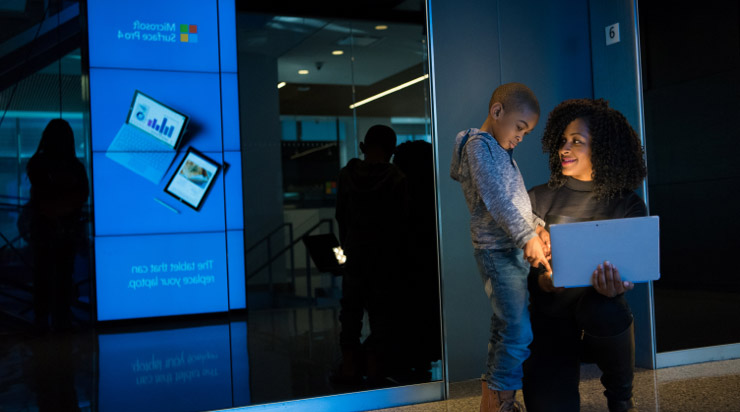Cybersecurity ensures that your organization’s data is protected from threats by both internal and external bad actors. It can refer to a set of technologies, methods, structures, and practices used to safeguard networks, computers, programs, and data from unwanted access or damage. The purpose of any cybersecurity plan is to maintain confidentiality, data integrity, and availability.
Why South African small businesses should take cybersecurity seriously?
As a small business owner, it’s easy to be lulled into believing that you’re not a target after reading seemingly endless headlines about cybersecurity breaches at enterprise corporations.
While the most high-profile attacks involve large corporations, cybercriminals do not discriminate based on size. Indeed, some of the most significant data breaches of the twenty-first century began at tiny organizations. The cyberattack on a large store in 2014, which exposed the personal information of over 100 million accounts, was carried out through the network of an HVAC contractor who worked for the chain.

What makes my business a target for hackers?
In South Africa, small and medium-sized firms lack the substantial finances that enterprise corporations possess. So, why do hackers target them so much? There are several main reasons:
Hackers target important data from small businesses, including medical records, credit card information, ID numbers, bank account credentials, and secret business information, which may be easily sold on the Dark Web. Cybercriminals are constantly attempting to find new ways to steal this information. They either utilize it to get access to bank accounts and make fraudulent transactions, or they sell it to other criminals for use.
● Cyberhackers may use a company’s systems to create bots and launch DDoS attacks. DDoS works by artificially creating massive quantities of web traffic in order to interrupt the service of a firm or group of companies. The hijacked bots contribute to the disruptive traffic.
● Links to the large fish: Businesses today rely on digital connections to perform transactions, manage supply chains, and communicate information. Because larger firms are theoretically (but not always) more difficult to enter, hackers target smaller partners in order to gain access to major company systems.
● Your cash, simply put: When you think about it, cybercriminals typically target small businesses—or any other company—for financial gain. Sure, some attacks, such as DDoS, are intended to cause disruption, but the primary goal is usually to profit. This explains why ransomware is such a common form of attack. It frequently succeeds, resulting in revenue for attackers. And as long as an attack method is profitable, hackers will keep utilizing it on small South African Small businesses.
“After all, a cybercriminal only has to be correct once. To prevent a successful attack, you must be correct 100% of the time.”
What are the threats?
Contact ZidoSoft for IT security services in Pretoria South Africa.
To attain peace of mind in today’s threat scenery, small business owners in South African must have a strong security policy. That level of preparedness begins with a thorough grasp of the present threats:
● Phishing can lead to ransomware or other infections by tricking users into clicking on a virus-containing email attachment or URL. Phishing has become increasingly sophisticated, and it can be extremely difficult to detect a bogus message as hackers target specific individuals with messages they can’t ignore.
●Ransomware is a prevalent strategy used by hackers to target organizations. Ransomware infects systems and encrypts data, holding it hostage. To restore access to their data, owners must pay a ransom to a hacker, who will then provide a decryption key.
●Malvertising, or “malware advertising,” involves sending malware to a network after a user clicks on a seemingly genuine ad. Malvertising is difficult to detect because it is so well disguised, however certain advanced malware detection technologies are improving.
● Clickjacking: Similar to malvertising, this tactic hides hyperlinks to hijacked webpages within legal website URLs. Users are then prompted to provide personal information that hackers have stolen for malicious purposes.
● Drive-by downloads: Malware is often installed without the user’s knowledge. Sometimes consumers must respond to a pop-up window before the download can begin, but other times all you have to do is unknowingly visit a hacked website.
● Hackers use software vulnerabilities in popular platforms like WordPress, Java, and file formats like HTML, PDF, and CSV to spread malware. Falling behind on updates might make systems especially susceptible.
Any business that ignores cybersecurity is taking a significant risk. And, as businesses become more linked, these risks spread to customers, partners, and suppliers.
To ensure peace of mind and protection against costly malware, ransomware, and bots, small businesses must install OPTIMUM cybersecurity measures such as antivirus software, firewalls, and network security solutions that proactively protect all devices linked to your network.
How South African small businesses may avoid cyberattacks?
System Use Policy
A system use policy generally defines the rules under which the organization’s IT systems can be utilized. Examples of elements to examine in this policy include:
Passwords are required on all platforms, including phones and tablets, and passwords must be changed on a regular basis. It is also prohibited to provide passwords to other team members or other parties.
Copying and deleting organization data from the office without authority is prohibited.
Encryption of memory and USB devices.
Physical security of equipment.
Use the system during business hours.
Rules for using the system privately, if permitted, outside of office hours.
Multifactor authentication entails employing more than one way of authentication from different categories of credentials to validate the user’s identity during login.
Email Use Policy
Example elements to be considered in an e-mail use policy include:
- The prohibition of the use of personal email accounts for business purposes.
- Restricting the opening of email attachments from unverified sources due to the potential presence of malicious software.Prohibiting accessing email accounts of other individuals.
- Restricting access to the email accounts of other individuals.
- Preventing the exchange of email account credentials.
- Limiting the use of the organization’s email for personal purposes.
- Notification that the organization will be monitoring email.
Internet Usage Policy
Examples of components that should be taken into account when formulating an internet use policy include:
Notification regarding the organization’s capacity to monitor Internet usage.
Restricting the use of the Internet to commercial purposes.
Restricting access to websites that are objectionable to an individual’s gender, sexuality, religion, nationality, or politics.
Guaranteeing that downloads are exclusively conducted from a reputable and secure website.
Preventing the download of executable (program) files, as they may contain malicious software, and also prohibiting the distribution of pirated music, movies, or software.
Limiting the probability of spam by prohibiting the provision of the user’s business email address.
The repercussions of a violation.
Policy for Remote Access
Examples of components that should be taken into account when formulating a remote access policy include:
- Approvals are necessary for external access.
- External access expenses reimbursement.
- Security protocols (such as the use of firewalls, the disconnection from other networks while accessing the organization’s systems, the disclosure of passwords, the installation of appropriate software to protect the remote system from malicious attacks, and multifactor authentication) are implemented.
- Laptops that are provided by the organization are subject to physical security measures.
- Notification of any potential security violation, unauthorized access, or disclosure of the organization’s data.
- Consent to the organization’s ability to monitor the external user’s activities in order to detect any suspicious or anomalous usage patterns.
- The repercussions of noncompliance.





We didn’t invent the term “fools with tools.” Still, it’s a perfect definition for the practice of buying a stack of sophisticated cybersecurity technology that’s impossible to manage without an MSP or the budget of a Fortune 500 IT department.